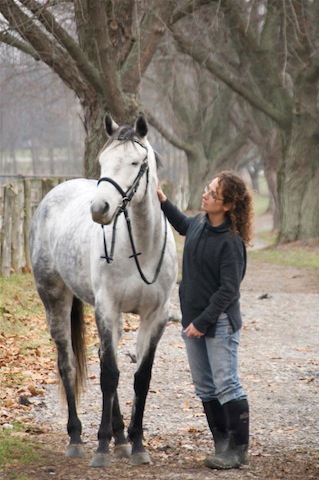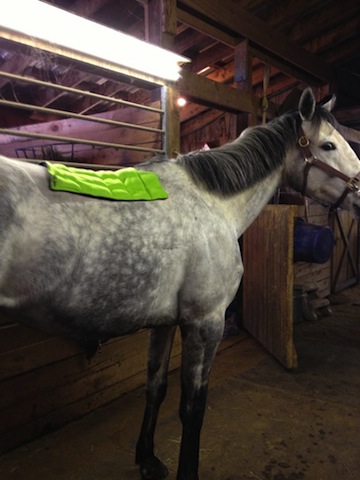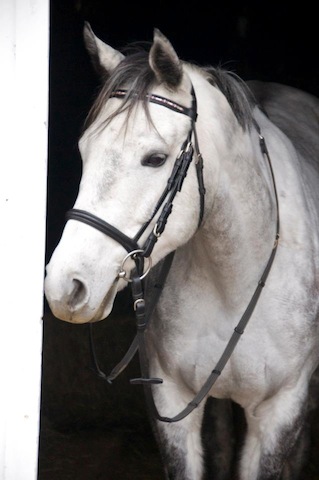Five weeks after undergoing pioneering surgery for Kissing Spine, the dappled gray ex-racehorse upon whom so many hopes for a cure now rest appears to be moving through her paces without pain. Radiographs due to be taken next week will confirm whether the procedure worked.
Heartly Smart is due to have a series of X-rays along the areas of her spine, once pinched uncomfortably by both overlapping and touching points.
On Feb. 18, Dr. Christy Cable, DVM, DACVS, performed the minor surgery on Heartly Smart, after studying the technique first performed in England on 35 horses diagnosed with Kissing Spine. After reading reports by veterinary peers that the surgery worked on 95 percent of the equines, Cable performed the same procedure on the mare who resides in New York.
“The study intrigued me because (surgeons) had done a number of horses, 35 to be exact, and by making minimally invasive keyhole incisions … removed the pain and increased the horse’s mobility,” Cable says in an earlier interview with Off Track Thoroughbreds.com
The surgery on Heartly Smart went as follows:
Radiographs of the mare’s spine were taken, and four areas of kissing spine identified and marked with metal tags. An ultrasound was also used to pinpoint the exact location of the “kissing” or touching spine.
After the mare was prepped and given a sedation regimen, similar to what is prescribed for a horse undergoing a dental procedure, incisions were made at the trouble spots, and an interspinous ligament desmotomy, or cutting of ligaments, was performed.
In the intervening weeks, Heartly Smart has undergone two weeks of stall rest, followed by a gradual return to groundwork, and if all goes well, will eventually progress to riding.
Working with her every day, Susan Swart, president of the New York chapter of ReRun, Inc., notes that she appears to be moving well; however, their work hit a minor obstacle when she displayed anxious behavior after a bit was placed in her mouth.
“She always tacked up quietly,” Swart says. “But, when I finally added the bit, she chomps so much on it that she becomes too busy with it to listen to my aids.”
Swart confirmed with Heartly Smart’s former owner Julianne Ragone, who donated the mare for the surgical procedure, that this is an old behavior she exhibited, even before she developed Kissing Spine.
“Julianne never rode this horse without having her chomp the bit,” Swart says.
After trying her in a loose-ring snaffle and a flash, and still failing to get the mare’s anxiety to diminish, Swart decided to begin working her in the Monty Roberts Dually Halter, equipment which allows Swart to maintain effective training techniques without use of a bit.
“There’s no reason I have to put a bit in her mouth. I went to my go-to Monty Roberts halter, and plan to change up her training completely,” Swart says, noting that her goal is to keep her quiet from her mouth, all the way back to her tail.
As soon as the bit was removed, she settled down. Her mouth remained still, and her tail ceased to swish, she says.
Applying this method, Swart will long-line her and attempt to get Heartly Smart to slow down.
“When they walk or trot too fast, that’s evasive, and it’s not really work. I am not letting her get away with it, and am shutting her down right away, which leads to her own little tantrum,” she says.
Swart remains hopeful that Heartly Smart will relax, and stop acting “like a two-year-old in a candy shop.” At which point, she will start her training under saddle.
“The issue is to address problem behavior at the beginning, or it will haunt you in every stage of their training,” says Swart, who adds that she is confident the six-year-old mare will emerge as a calm, riding horse.
And the greater hope is that the X-rays scheduled for next week will open doors in the treatment of the debilitating and costly condition, Kissing Spine.
“If the surgery is a success, it will open doors” for horses and owners facing the worst cases of Kissing Spine, Dr. Cable says in the earlier interview.
“It’s very promising.”





Nothing new about this surgery. Was being done at New Bolton Center in the early 1970’s, performed by an English vet. named Roberts, who had done the original cases in England. Unfortunately the case selection was somewhat indescriminate in the majority of cases; I had responsibility for aftercare as I was an intern/resident at the time. Many of the horses did not have any degenerative bony changes in their dorsal spinous processes and would likely have responded equally well to more conservative medical therapy. Now shock wave therapy has been added to medical therapy, so the success rate in treating degenerative backs has markedly increased and the surgery which removes the tips of the DSPs has fallen into disuse. Certainly some of the most severely affected horses, which Heartly Smart may be, may benefit from the surgery. Kudos to Dr. Cable for performing the technique in a standing patient with sedation and local anesthesia. Hope all goes well.
Midge Leitch, VMD
Diplomate, American College of Veterinary Surgeons